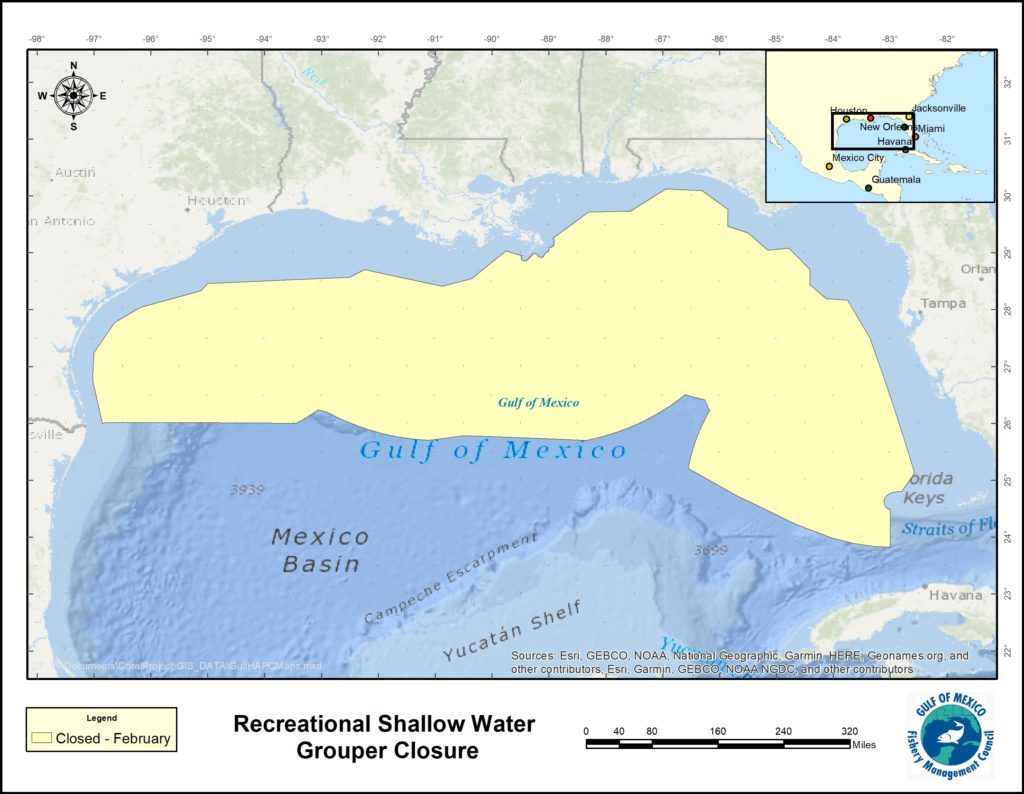
Scientific Name
Mycteroperca bonaci
Common Name
Carbo
Stock Status
Overfishing – No
Overfished – No
Stock Assessment
Recreational Regulations
Federal Regulations
-
Open: January 01 – January 31
Closed: February 01 – March 31
Open: March 31 – December 31
- 4 Bag Limit
- 4 Aggregate Limit
- Minimum Size: 24 in Total Length
Gear Description: Non-stainless steel circle hooks are required when fishing with natural baits. At least one dehooking device is required and must be used to remove hooks.
Notes:
Anglers required to have a venting tool or descending device rigged and ready to use when fishing for reef fish species in Gulf of Mexico federal waters. For more information, see NOAA Descend Act.
Shallow-water Grouper Closure (Map of the 20-fathom break)
Title 50 CFR: Wildlife and Fisheries – PART 622 FISHERIES OF THE CARIBBEAN, GULF OF MEXICO, AND SOUTH ATLANTIC
Subpart B – Reef Fish Resources of the Gulf of Mexico – §622.34 Seasonal and area closures designed to protect Gulf reef fish
(d) Seasonal closure of the recreational sector for shallow-water grouper (SWG). The recreational sector for SWG, in or from the Gulf EEZ, is closed each year from February 1 through March 31, in the portion of the Gulf EEZ seaward of rhumb lines connecting, in order, the points in the following table. During the closure, the bag and possession limit for SWG in or from the Gulf EEZ seaward of the following rhumb lines is zero.


Commercial Regulations
Harvest Limits
| Combined stock ACL black grouper, scamp, yellowfin grouper, and yellowmouth grouper – 710,000 pounds |
| Combined Commercial ACL for black grouper, scamp, yellowfin grouper, and yellowmouth grouper – 547,000 pounds |
| Combined Commercial quota for black grouper, scamp, yellowfin grouper, and yellowmouth grouper – 525,000 pounds |
Additional Information
Description
Black grouper is found in the western Atlantic from Massachusetts south to southern Brazil, including Bermuda, the Gulf of Mexico, Bahamas and Caribbean Sea. Adults appear to be absent in the northernmost portion of this range near Massachusetts. This fish is a grayish olive color with dark grayish brown spots, or kiss-like marks, on its sides that form rectangular chain-like patterns or hexagonal shapes. The pectoral fins have a yellowish orange margin. It has a protruding lower jaw and unlike gag, the bottom of the black grouper’s cheek (preopercle) is gently rounded with no notch.
Maximum observed age: 33 years1, 2
Age at maturity: ~5 to 7 years1, 3
Maximum weight: 220.46 pounds (100 kilograms)4
Maximum length: 59.06 inches (150 centimeters)1
Life History and Distribution
Black grouper lives offshore and prefers rocky bottoms and coral reefs. Juveniles inhabit inshore areas in seagrass beds and mangroves. Younger fish move into deeper waters as they mature. Adults are solitary but they do form spawning aggregations. Spawning occurs during winter months from November to May but varies by region. As protogynous hermaphrodites, black grouper start as female and most transition to male around 15.5 years.5
References
- Kobara, S., B. Erisman, W. Heyman, C. Biggs, N. Farmer, S. Lowerre-Barbieri, M. Karnauskas, and J. Brenner. 2017. Cooperative monitoring program for spawning aggregations in the Gulf of Mexico: data portal. Version 1.0 GCOOS, USA.
- SEDAR 48 Southeastern U.S. Black Grouper: Data Workshop Report, 2017
- Farmer, N.A., Malinowski, R.P., McGovern, M.F. and Rubec, P.J. (2016), Stock Complexes for Fisheries Management in the Gulf of Mexico. Marine and Coastal Fisheries, 8: 177-201. doi:10.1080/19425120.2015.1024359
- Claro, R., 1994. Características generales de la ictiofauna. p. 55-70. In R. Claro (ed.) Ecología de los peces marinos de Cuba. Instituto de Oceanología Academia de Ciencias de Cuba and Centro de Investigaciones de Quintana Roo.
- Allsop, D.J. and S.A. West, 2003. Constant relative age and size at sex change for sequentially hermaphroditic fish. J. Evol. Biol. 16(2003):921-929.

